Strategies for Inter-Departmental Cooperation at Condé Nast Johansens
VerifiedAdded on 2021/02/20
|12
|1786
|346
Report
AI Summary
This report provides an analysis of inter-departmental cooperation within Condé Nast Johansens, a global luxury hotel, spa, and venue chain. The report identifies key strategies to enhance collaboration, including cultivating empathy, developing a common language, motivating information sharing, and fostering trust. It also examines various communication barriers such as linguistic, cultural, psychological, emotional, and organizational structure issues. Furthermore, the report suggests strategies to overcome these barriers, such as eliminating perception differences, using simple language, simplifying organizational structure, avoiding information overload, and providing constructive feedback. The findings aim to improve operational efficiency and achieve organizational goals within Condé Nast Johansens.
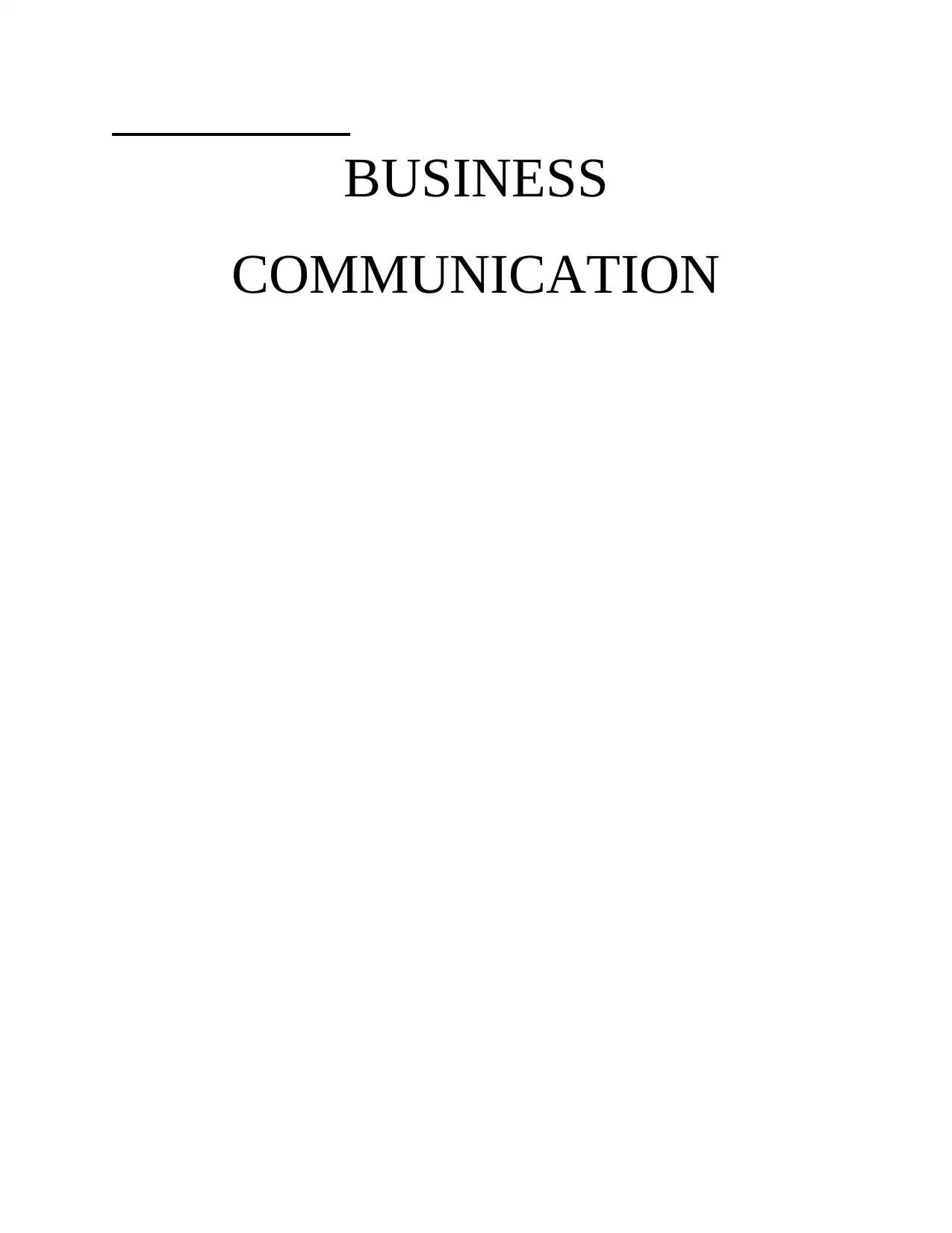
BUSINESS
COMMUNICATION
COMMUNICATION
Paraphrase This Document
Need a fresh take? Get an instant paraphrase of this document with our AI Paraphraser

Contents
INTRODUCTION...........................................................................................................................3
Main Body.......................................................................................................................................3
1. Recommended measures to facilitate inter-departmental cooperation in Condé Nast
Johansens,...............................................................................................................................3
2. Barriers in communication and strategy to overcome........................................................4
CONCLUSION................................................................................................................................6
REFERENCES................................................................................................................................7
INTRODUCTION...........................................................................................................................3
Main Body.......................................................................................................................................3
1. Recommended measures to facilitate inter-departmental cooperation in Condé Nast
Johansens,...............................................................................................................................3
2. Barriers in communication and strategy to overcome........................................................4
CONCLUSION................................................................................................................................6
REFERENCES................................................................................................................................7

INTRODUCTION
Interrelation and cooperation between different departments of an organisation is highly
essential for achieving the organisational success and goals. Each and every department within a
business needs to work together so that all the activities or task can be performed in an effective
manner. The present report is in context to Condé Nast Johansens, a leading chain of luxury
hotels, spas and venues globally. Condé Nast Johansens has more than 35 years of experience
inspecting and recommending luxury properties all round the world. The study will focus on
recommending measures to facilitate inter-departmental cooperation and overcome the barriers
of communication.
Main Body
1. Recommended measures to facilitate inter-departmental cooperation in Condé Nast Johansens,
Inter-departmental cooperation is very much essential mainly in Conde Nast Johansens as it
have many different types of departments operating in many different countries in the world. It
also deals in a large variety of services such as Hotels, Spa, Resorts and other properties for their
customers. In order to improve the coordination, increase effectiveness and efficiency in business
operations Conde Nast Johansens can use the following strategies –
Cultivating empathy – According to Iglesias, A. and et.al.,(2018), having good mutual
understanding between different departments can collaboration more effective and smoother.
Motivating teams or department to share and try each other’s work can let each team feel the
challenges other department faces. It helps the employees in understanding the differences and
challenges faced by team or employees working in other departments. Conde Nast Johansens can
cultivate a sense if curiosity among the employees or team in different departments in order to
assist them in learning each other’s work as well as come up with new ideas of improving
processes in every department and increase effectiveness in overall business operations.
Developing a common language – There are many confusions arises when employees do not
use a common language or understanding of terms in interdepartmental communications. It can
be frustrating for every department and team as well as it can leads to miscommunication which
can be a reason of failure or loss to the business. For improving cross functional
communications, developing that would be shared during new employee’s onboarding
procedure. As per the views of Lozovitskaya and Weerakit (2018), it is important to learn from
Interrelation and cooperation between different departments of an organisation is highly
essential for achieving the organisational success and goals. Each and every department within a
business needs to work together so that all the activities or task can be performed in an effective
manner. The present report is in context to Condé Nast Johansens, a leading chain of luxury
hotels, spas and venues globally. Condé Nast Johansens has more than 35 years of experience
inspecting and recommending luxury properties all round the world. The study will focus on
recommending measures to facilitate inter-departmental cooperation and overcome the barriers
of communication.
Main Body
1. Recommended measures to facilitate inter-departmental cooperation in Condé Nast Johansens,
Inter-departmental cooperation is very much essential mainly in Conde Nast Johansens as it
have many different types of departments operating in many different countries in the world. It
also deals in a large variety of services such as Hotels, Spa, Resorts and other properties for their
customers. In order to improve the coordination, increase effectiveness and efficiency in business
operations Conde Nast Johansens can use the following strategies –
Cultivating empathy – According to Iglesias, A. and et.al.,(2018), having good mutual
understanding between different departments can collaboration more effective and smoother.
Motivating teams or department to share and try each other’s work can let each team feel the
challenges other department faces. It helps the employees in understanding the differences and
challenges faced by team or employees working in other departments. Conde Nast Johansens can
cultivate a sense if curiosity among the employees or team in different departments in order to
assist them in learning each other’s work as well as come up with new ideas of improving
processes in every department and increase effectiveness in overall business operations.
Developing a common language – There are many confusions arises when employees do not
use a common language or understanding of terms in interdepartmental communications. It can
be frustrating for every department and team as well as it can leads to miscommunication which
can be a reason of failure or loss to the business. For improving cross functional
communications, developing that would be shared during new employee’s onboarding
procedure. As per the views of Lozovitskaya and Weerakit (2018), it is important to learn from
⊘ This is a preview!⊘
Do you want full access?
Subscribe today to unlock all pages.

Trusted by 1+ million students worldwide
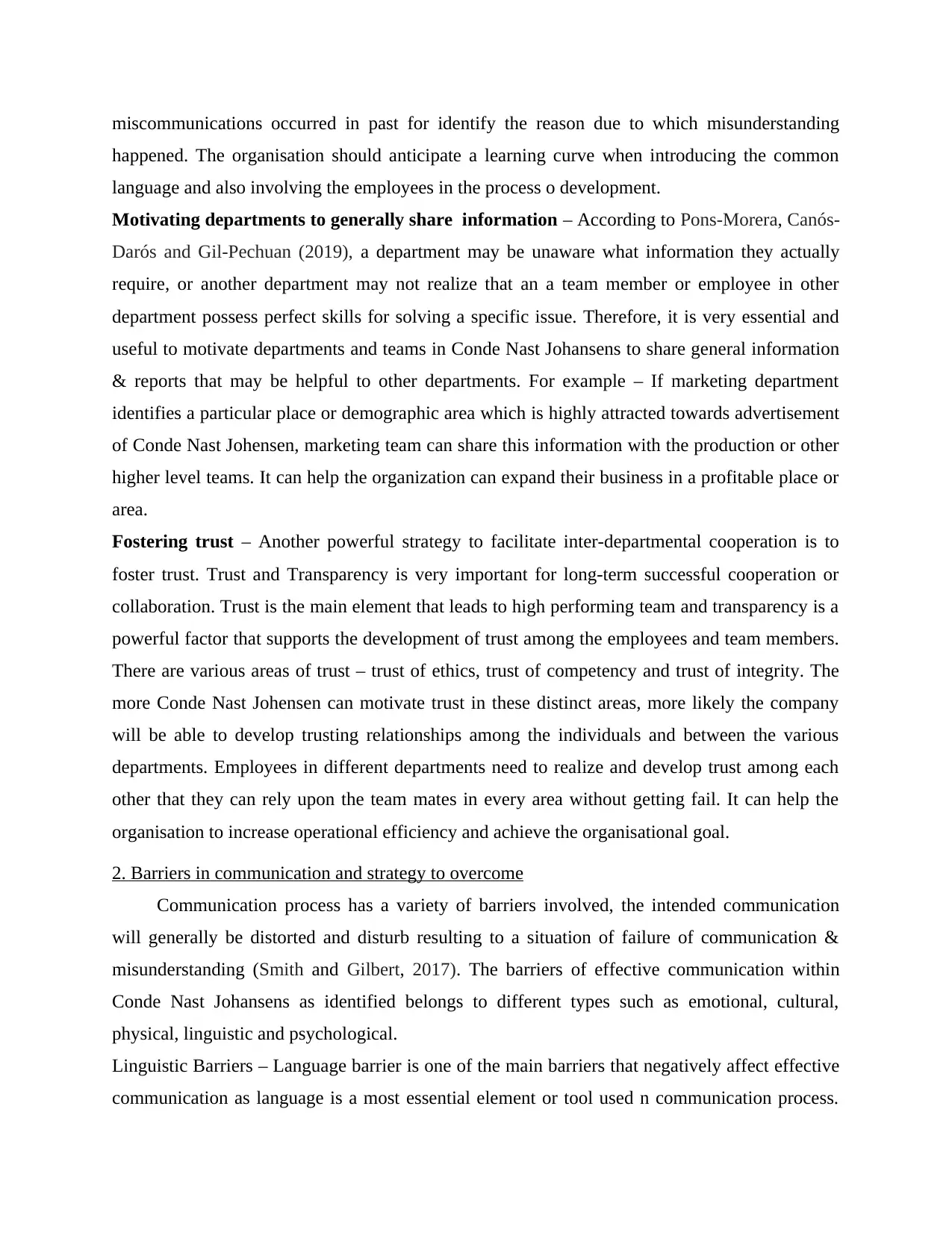
miscommunications occurred in past for identify the reason due to which misunderstanding
happened. The organisation should anticipate a learning curve when introducing the common
language and also involving the employees in the process o development.
Motivating departments to generally share information – According to Pons-Morera, Canós-
Darós and Gil-Pechuan (2019), a department may be unaware what information they actually
require, or another department may not realize that an a team member or employee in other
department possess perfect skills for solving a specific issue. Therefore, it is very essential and
useful to motivate departments and teams in Conde Nast Johansens to share general information
& reports that may be helpful to other departments. For example – If marketing department
identifies a particular place or demographic area which is highly attracted towards advertisement
of Conde Nast Johensen, marketing team can share this information with the production or other
higher level teams. It can help the organization can expand their business in a profitable place or
area.
Fostering trust – Another powerful strategy to facilitate inter-departmental cooperation is to
foster trust. Trust and Transparency is very important for long-term successful cooperation or
collaboration. Trust is the main element that leads to high performing team and transparency is a
powerful factor that supports the development of trust among the employees and team members.
There are various areas of trust – trust of ethics, trust of competency and trust of integrity. The
more Conde Nast Johensen can motivate trust in these distinct areas, more likely the company
will be able to develop trusting relationships among the individuals and between the various
departments. Employees in different departments need to realize and develop trust among each
other that they can rely upon the team mates in every area without getting fail. It can help the
organisation to increase operational efficiency and achieve the organisational goal.
2. Barriers in communication and strategy to overcome
Communication process has a variety of barriers involved, the intended communication
will generally be distorted and disturb resulting to a situation of failure of communication &
misunderstanding (Smith and Gilbert, 2017). The barriers of effective communication within
Conde Nast Johansens as identified belongs to different types such as emotional, cultural,
physical, linguistic and psychological.
Linguistic Barriers – Language barrier is one of the main barriers that negatively affect effective
communication as language is a most essential element or tool used n communication process.
happened. The organisation should anticipate a learning curve when introducing the common
language and also involving the employees in the process o development.
Motivating departments to generally share information – According to Pons-Morera, Canós-
Darós and Gil-Pechuan (2019), a department may be unaware what information they actually
require, or another department may not realize that an a team member or employee in other
department possess perfect skills for solving a specific issue. Therefore, it is very essential and
useful to motivate departments and teams in Conde Nast Johansens to share general information
& reports that may be helpful to other departments. For example – If marketing department
identifies a particular place or demographic area which is highly attracted towards advertisement
of Conde Nast Johensen, marketing team can share this information with the production or other
higher level teams. It can help the organization can expand their business in a profitable place or
area.
Fostering trust – Another powerful strategy to facilitate inter-departmental cooperation is to
foster trust. Trust and Transparency is very important for long-term successful cooperation or
collaboration. Trust is the main element that leads to high performing team and transparency is a
powerful factor that supports the development of trust among the employees and team members.
There are various areas of trust – trust of ethics, trust of competency and trust of integrity. The
more Conde Nast Johensen can motivate trust in these distinct areas, more likely the company
will be able to develop trusting relationships among the individuals and between the various
departments. Employees in different departments need to realize and develop trust among each
other that they can rely upon the team mates in every area without getting fail. It can help the
organisation to increase operational efficiency and achieve the organisational goal.
2. Barriers in communication and strategy to overcome
Communication process has a variety of barriers involved, the intended communication
will generally be distorted and disturb resulting to a situation of failure of communication &
misunderstanding (Smith and Gilbert, 2017). The barriers of effective communication within
Conde Nast Johansens as identified belongs to different types such as emotional, cultural,
physical, linguistic and psychological.
Linguistic Barriers – Language barrier is one of the main barriers that negatively affect effective
communication as language is a most essential element or tool used n communication process.
Paraphrase This Document
Need a fresh take? Get an instant paraphrase of this document with our AI Paraphraser
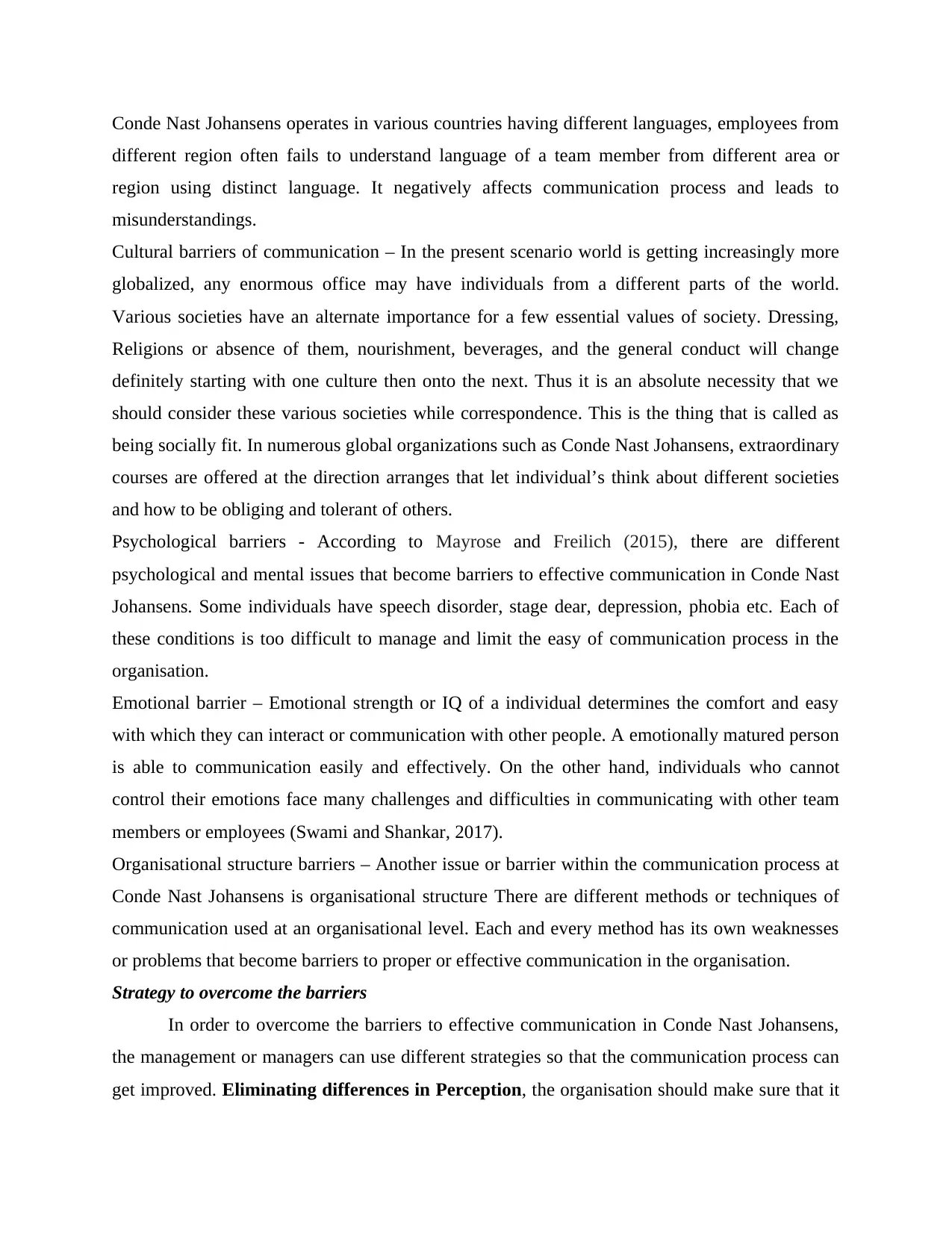
Conde Nast Johansens operates in various countries having different languages, employees from
different region often fails to understand language of a team member from different area or
region using distinct language. It negatively affects communication process and leads to
misunderstandings.
Cultural barriers of communication – In the present scenario world is getting increasingly more
globalized, any enormous office may have individuals from a different parts of the world.
Various societies have an alternate importance for a few essential values of society. Dressing,
Religions or absence of them, nourishment, beverages, and the general conduct will change
definitely starting with one culture then onto the next. Thus it is an absolute necessity that we
should consider these various societies while correspondence. This is the thing that is called as
being socially fit. In numerous global organizations such as Conde Nast Johansens, extraordinary
courses are offered at the direction arranges that let individual’s think about different societies
and how to be obliging and tolerant of others.
Psychological barriers - According to Mayrose and Freilich (2015), there are different
psychological and mental issues that become barriers to effective communication in Conde Nast
Johansens. Some individuals have speech disorder, stage dear, depression, phobia etc. Each of
these conditions is too difficult to manage and limit the easy of communication process in the
organisation.
Emotional barrier – Emotional strength or IQ of a individual determines the comfort and easy
with which they can interact or communication with other people. A emotionally matured person
is able to communication easily and effectively. On the other hand, individuals who cannot
control their emotions face many challenges and difficulties in communicating with other team
members or employees (Swami and Shankar, 2017).
Organisational structure barriers – Another issue or barrier within the communication process at
Conde Nast Johansens is organisational structure There are different methods or techniques of
communication used at an organisational level. Each and every method has its own weaknesses
or problems that become barriers to proper or effective communication in the organisation.
Strategy to overcome the barriers
In order to overcome the barriers to effective communication in Conde Nast Johansens,
the management or managers can use different strategies so that the communication process can
get improved. Eliminating differences in Perception, the organisation should make sure that it
different region often fails to understand language of a team member from different area or
region using distinct language. It negatively affects communication process and leads to
misunderstandings.
Cultural barriers of communication – In the present scenario world is getting increasingly more
globalized, any enormous office may have individuals from a different parts of the world.
Various societies have an alternate importance for a few essential values of society. Dressing,
Religions or absence of them, nourishment, beverages, and the general conduct will change
definitely starting with one culture then onto the next. Thus it is an absolute necessity that we
should consider these various societies while correspondence. This is the thing that is called as
being socially fit. In numerous global organizations such as Conde Nast Johansens, extraordinary
courses are offered at the direction arranges that let individual’s think about different societies
and how to be obliging and tolerant of others.
Psychological barriers - According to Mayrose and Freilich (2015), there are different
psychological and mental issues that become barriers to effective communication in Conde Nast
Johansens. Some individuals have speech disorder, stage dear, depression, phobia etc. Each of
these conditions is too difficult to manage and limit the easy of communication process in the
organisation.
Emotional barrier – Emotional strength or IQ of a individual determines the comfort and easy
with which they can interact or communication with other people. A emotionally matured person
is able to communication easily and effectively. On the other hand, individuals who cannot
control their emotions face many challenges and difficulties in communicating with other team
members or employees (Swami and Shankar, 2017).
Organisational structure barriers – Another issue or barrier within the communication process at
Conde Nast Johansens is organisational structure There are different methods or techniques of
communication used at an organisational level. Each and every method has its own weaknesses
or problems that become barriers to proper or effective communication in the organisation.
Strategy to overcome the barriers
In order to overcome the barriers to effective communication in Conde Nast Johansens,
the management or managers can use different strategies so that the communication process can
get improved. Eliminating differences in Perception, the organisation should make sure that it
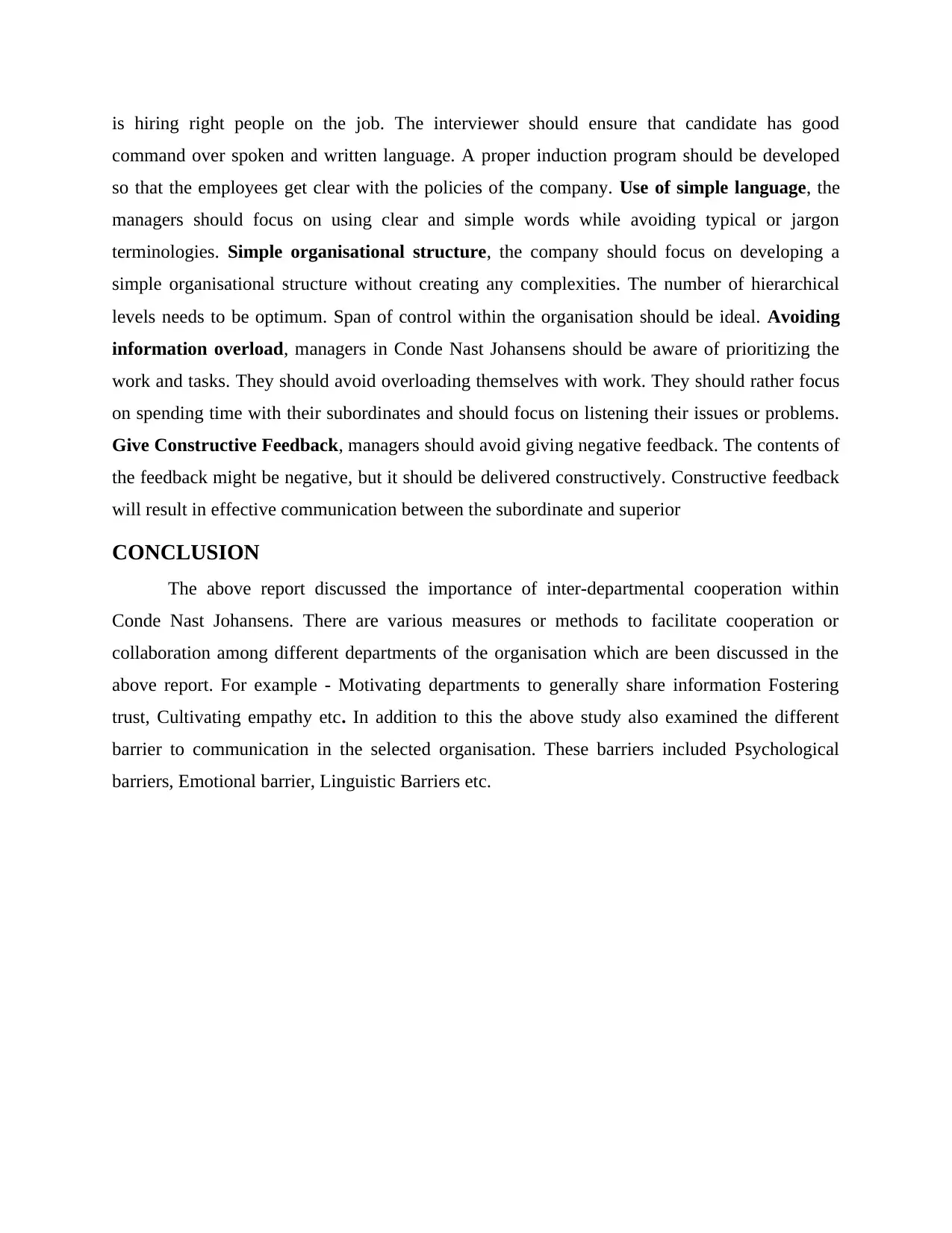
is hiring right people on the job. The interviewer should ensure that candidate has good
command over spoken and written language. A proper induction program should be developed
so that the employees get clear with the policies of the company. Use of simple language, the
managers should focus on using clear and simple words while avoiding typical or jargon
terminologies. Simple organisational structure, the company should focus on developing a
simple organisational structure without creating any complexities. The number of hierarchical
levels needs to be optimum. Span of control within the organisation should be ideal. Avoiding
information overload, managers in Conde Nast Johansens should be aware of prioritizing the
work and tasks. They should avoid overloading themselves with work. They should rather focus
on spending time with their subordinates and should focus on listening their issues or problems.
Give Constructive Feedback, managers should avoid giving negative feedback. The contents of
the feedback might be negative, but it should be delivered constructively. Constructive feedback
will result in effective communication between the subordinate and superior
CONCLUSION
The above report discussed the importance of inter-departmental cooperation within
Conde Nast Johansens. There are various measures or methods to facilitate cooperation or
collaboration among different departments of the organisation which are been discussed in the
above report. For example - Motivating departments to generally share information Fostering
trust, Cultivating empathy etc. In addition to this the above study also examined the different
barrier to communication in the selected organisation. These barriers included Psychological
barriers, Emotional barrier, Linguistic Barriers etc.
command over spoken and written language. A proper induction program should be developed
so that the employees get clear with the policies of the company. Use of simple language, the
managers should focus on using clear and simple words while avoiding typical or jargon
terminologies. Simple organisational structure, the company should focus on developing a
simple organisational structure without creating any complexities. The number of hierarchical
levels needs to be optimum. Span of control within the organisation should be ideal. Avoiding
information overload, managers in Conde Nast Johansens should be aware of prioritizing the
work and tasks. They should avoid overloading themselves with work. They should rather focus
on spending time with their subordinates and should focus on listening their issues or problems.
Give Constructive Feedback, managers should avoid giving negative feedback. The contents of
the feedback might be negative, but it should be delivered constructively. Constructive feedback
will result in effective communication between the subordinate and superior
CONCLUSION
The above report discussed the importance of inter-departmental cooperation within
Conde Nast Johansens. There are various measures or methods to facilitate cooperation or
collaboration among different departments of the organisation which are been discussed in the
above report. For example - Motivating departments to generally share information Fostering
trust, Cultivating empathy etc. In addition to this the above study also examined the different
barrier to communication in the selected organisation. These barriers included Psychological
barriers, Emotional barrier, Linguistic Barriers etc.
⊘ This is a preview!⊘
Do you want full access?
Subscribe today to unlock all pages.

Trusted by 1+ million students worldwide
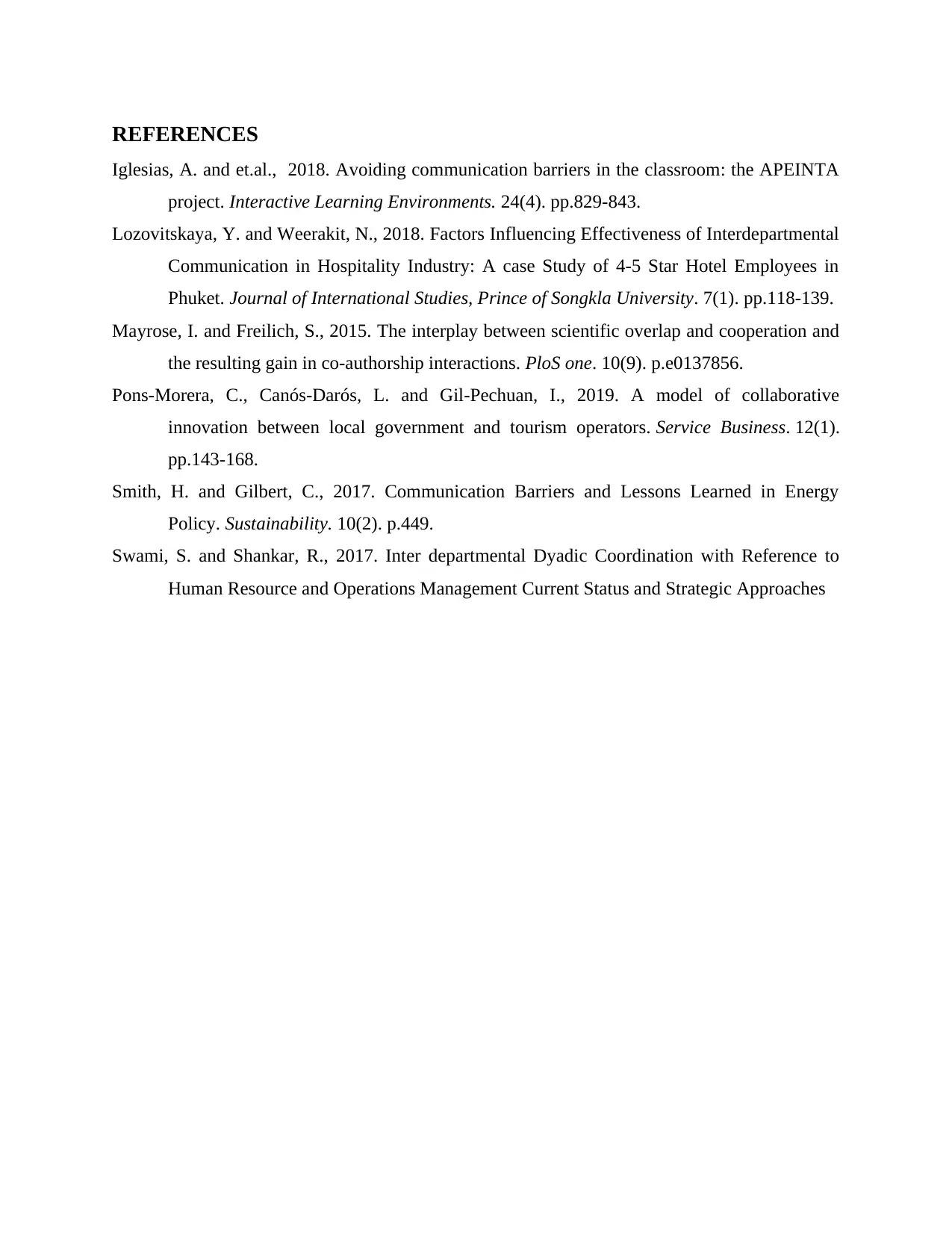
REFERENCES
Iglesias, A. and et.al., 2018. Avoiding communication barriers in the classroom: the APEINTA
project. Interactive Learning Environments. 24(4). pp.829-843.
Lozovitskaya, Y. and Weerakit, N., 2018. Factors Influencing Effectiveness of Interdepartmental
Communication in Hospitality Industry: A case Study of 4-5 Star Hotel Employees in
Phuket. Journal of International Studies, Prince of Songkla University. 7(1). pp.118-139.
Mayrose, I. and Freilich, S., 2015. The interplay between scientific overlap and cooperation and
the resulting gain in co-authorship interactions. PloS one. 10(9). p.e0137856.
Pons-Morera, C., Canós-Darós, L. and Gil-Pechuan, I., 2019. A model of collaborative
innovation between local government and tourism operators. Service Business. 12(1).
pp.143-168.
Smith, H. and Gilbert, C., 2017. Communication Barriers and Lessons Learned in Energy
Policy. Sustainability. 10(2). p.449.
Swami, S. and Shankar, R., 2017. Inter departmental Dyadic Coordination with Reference to
Human Resource and Operations Management Current Status and Strategic Approaches
Iglesias, A. and et.al., 2018. Avoiding communication barriers in the classroom: the APEINTA
project. Interactive Learning Environments. 24(4). pp.829-843.
Lozovitskaya, Y. and Weerakit, N., 2018. Factors Influencing Effectiveness of Interdepartmental
Communication in Hospitality Industry: A case Study of 4-5 Star Hotel Employees in
Phuket. Journal of International Studies, Prince of Songkla University. 7(1). pp.118-139.
Mayrose, I. and Freilich, S., 2015. The interplay between scientific overlap and cooperation and
the resulting gain in co-authorship interactions. PloS one. 10(9). p.e0137856.
Pons-Morera, C., Canós-Darós, L. and Gil-Pechuan, I., 2019. A model of collaborative
innovation between local government and tourism operators. Service Business. 12(1).
pp.143-168.
Smith, H. and Gilbert, C., 2017. Communication Barriers and Lessons Learned in Energy
Policy. Sustainability. 10(2). p.449.
Swami, S. and Shankar, R., 2017. Inter departmental Dyadic Coordination with Reference to
Human Resource and Operations Management Current Status and Strategic Approaches
Paraphrase This Document
Need a fresh take? Get an instant paraphrase of this document with our AI Paraphraser


9
⊘ This is a preview!⊘
Do you want full access?
Subscribe today to unlock all pages.

Trusted by 1+ million students worldwide

10
Paraphrase This Document
Need a fresh take? Get an instant paraphrase of this document with our AI Paraphraser

1

2
⊘ This is a preview!⊘
Do you want full access?
Subscribe today to unlock all pages.

Trusted by 1+ million students worldwide
1 out of 12
Related Documents
Your All-in-One AI-Powered Toolkit for Academic Success.
+13062052269
info@desklib.com
Available 24*7 on WhatsApp / Email
![[object Object]](/_next/static/media/star-bottom.7253800d.svg)
Unlock your academic potential
Copyright © 2020–2025 A2Z Services. All Rights Reserved. Developed and managed by ZUCOL.




